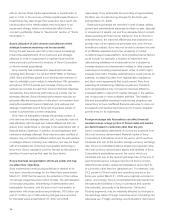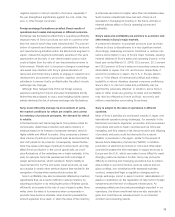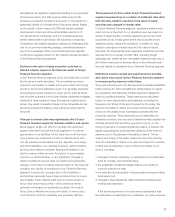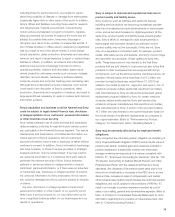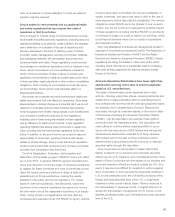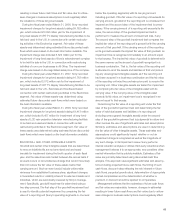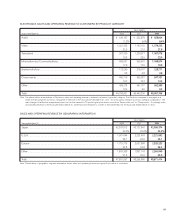Sony 2008 Annual Report Download - page 84
Download and view the complete annual report
Please find page 84 of the 2008 Sony annual report below. You can navigate through the pages in the report by either clicking on the pages listed below, or by using the keyword search tool below to find specific information within the annual report.82
CRITICAL ACCOUNTING POLICIES
The preparation of the consolidated financial statements in
conformity with U.S. GAAP requires management to make
estimates and assumptions that affect the reported amounts of
assets and liabilities, disclosure of contingent assets and
liabilities at the date of the financial statements and the reported
amounts of revenues and expenses during the reporting period.
On an ongoing basis, Sony evaluates its estimates which are
based on historical experience and on various other assump-
tions that are believed to be reasonable under the circum-
stances. The results of these evaluations form the basis for
making judgments about the carrying values of assets and
liabilities and the reported amounts of expenses that are not
readily apparent from other sources. Actual results may differ
from these estimates under different assumptions. Sony
considers an accounting policy to be critical if it is important
to its financial condition and results, and requires significant
judgment and estimates on the part of management in its
application. Sony believes that the following represent its critical
accounting policies.
■ INVESTMENTS
Sony’s investments are comprised of debt and equity securities
accounted for under both the cost and equity method of
accounting. If it has been determined that an investment has
sustained an other-than-temporary decline in its value, the
investment is written down to its fair value by a charge to
earnings. Sony regularly evaluates its investment portfolio to
identify other-than-temporary impairments of individual securi-
ties. Factors that are considered by Sony in determining whether
an other-than-temporary decline in value has occurred include:
the length of time and extent to which the market value of the
security has been less than its original cost, the financial
condition, operating results, business plans and estimated future
cash flows of the issuer of the security, other specific factors
affecting the market value, deterioration of credit condition of the
issuers, sovereign risk, and whether or not Sony is able to retain
the investment for a period of time sufficient to allow for the
anticipated recovery in market value.
In evaluating the factors for available-for-sale securities whose
fair values are readily determinable, Sony presumes a decline in
value to be other-than-temporary if the fair value of the security
is 20 percent or more below its original cost for an extended
period of time (generally for a period of up to six months). This
criterion is employed as a threshold to identify securities that
may have a decline in value that is other-than-temporary. The
presumption of an other-than-temporary impairment in such
cases may be overcome if there is evidence to support that the
decline is temporary in nature due to the existence of positive
factors that overcome the duration or magnitude of the decline.
On the other hand, there may be cases where impairment
losses are recognized when the decline in the fair value of the
security is less than 20 percent or such decline has not existed
for an extended period of time, as a result of considering specific
factors that may indicate the decline in the fair value is other-
than-temporary.
The assessment of whether a decline in the value of an
investment is other-than-temporary is often subjective in nature
and involves certain assumptions and estimates concerning the
expected operating results, business plans and future cash
flows of the issuer of the security. Accordingly, it is possible that
investments in Sony’s portfolio that have had a decline in value
that Sony currently believes to be temporary may be determined
to be other-than-temporary in the future based on Sony’s
evaluation of additional information such as continued poor
operating results, future broad declines in value of worldwide
equity markets and the effect of worldwide interest rate fluctua-
tions. As a result, unrealized losses recorded for investments
may be recognized and reduce income in future periods.
■ VALUATION OF INVENTORY
Sony values its inventory based on the lower of cost or market.
Sony writes down inventory in an amount equal to the differ-
ence between the cost of the inventory and the net realizable
value—i.e., less reasonably predictable costs of completion
and disposal. However, if actual market conditions are less
favorable than projected and further price decreases are
needed, additional inventory write-downs may be required.
Additionally, as Sony evaluates its manufacturing cost in yen
while it sets its sales prices in euros and U.S. dollars for some
products, Sony’s results may be negatively impacted by future
exchange rate fluctuations.
■ IMPAIRMENT OF LONG-LIVED ASSETS
Sony reviews the recoverability of the carrying value of its
long-lived assets held and used and long-lived assets to be
disposed of whenever events or changes in circumstances
indicate that the carrying value of the assets may not be
recoverable. This review is performed using estimates of future
cash flows by product category (e.g. CRT TV display) or entity
(e.g. entertainment complex in the U.S.). If the carrying value of
the asset is considered impaired, an impairment charge is
recorded for the amount by which the carrying value of the asset
exceeds its fair value. Fair value is determined using the present
value of estimated net cash flows or comparable market values.
Management believes that the estimates of future cash flows
and fair value are reasonable; however, changes in estimates




